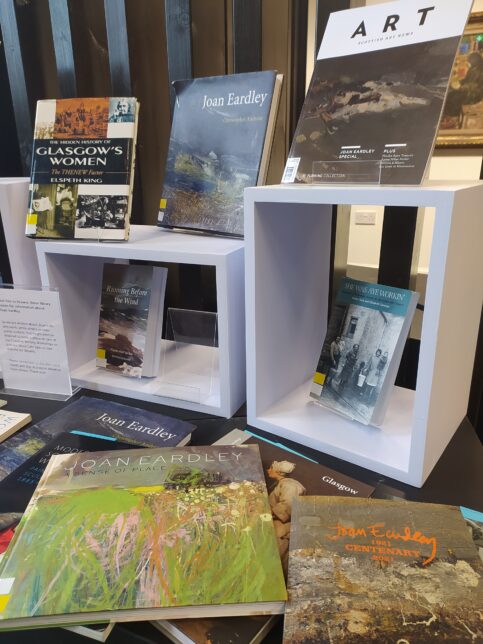
2021 marks one hundred years since the birth of artist Joan Eardley. We are delighted and a privileged to host an exhibition featuring five of Joan’s paintings until Saturday 12th February 2022. This blog provides a bit of information about Joan’s life and works. If you want to find out more, you might like to explore the links to references, listed below, or check out some of the books the library has about this immensely talented and influential woman.
Joan Kathleen Harding Eardley was born in Sussex on 18th May 1921 to Irene and William Eardley. Her parents met during World War I when William was stationed at Maryhill Barracks in Glasgow and they married at the end of the war. Irene was Scottish and William was English. Despite being born and living in England for the first eighteen years of her life, Joan is regarded as a Scottish painter, because Glasgow and the Scottish east coast village of Catterline were to become her homes and main subject matter.
In 1925 Irene took Joan and her younger sister Pat to live in London with Joan’s grandmother Ellen and her aunt Sybil. The childrens’ education was paid for by wealthy great-aunts and it was the art teacher named Miss Waddland at the girls’ secondary school (St. Helen’s School) who was one of the first to notice Joan’s talent.
While he was a soldier in France during the war William had been gassed and consequently he suffered from shell-shock – which we would now recognise as Post-Traumatic Stress Disorder (PTSD) – as well as depression. He died by suicide three years after the move to London and as a result Joan grew up in a family of women. Irene was a huge supporter of Joan’s desire to become an artist. Ellen and Sybil were also very important figures in Joan’s life; she had great affection for them. Sybil was an extraordinary women: a suffragist and a campaigner for peace, and her firm belief in women’s rights would have a long lasting effect on Joan’s own views.
After leaving St. Helen’s Joan completed two terms at a local art school and two terms at Goldsmiths College. By January 1940 the family had moved from London to Bearsden in Glasgow and Joan became a student at Glasgow School of Art.
Here she met Margot Sandeman who would go on to be a lifelong friend. It was also here that her talent gained wider recognition from teachers at the school as well as art critics. For example Joan’s painting entitled “Self Portrait” completed in 1943 won her the Sir James Guthrie Prize for portraiture.
https://artuk.org/discover/artworks/joan-eardley-19211963-artist-212297
Later in 1943 Joan completed one term at Jordanhill Teacher Training College but she decided that being an educator was not what she wanted to do. It is interesting to note that although she chose not to be based in a classroom, there is much that can be learned from her art. Instead of teaching, Joan decided to work as a joiner’s apprentice. This work (which included painting camouflage patterns on ships) allowed her to attend evening classes at Glasgow School of Art.
In 1947 Joan continued her studies at Hospitalfield House in Arbroath under the tutelage of James Cowie. In letters to her friends and family we learn while Joan often disagreed with James on artistic matters she was also learning a lot from him. Whilst at Hospitalfield Joan also met Angus Neil who became another important figure in her life.
One significant way that James influenced Joan was the choosing of everyday subject matter. Joan’s friend Margot actually began painting children before Joan began doing so. Children in Glasgow would be the focal point of many of the paintings Joan completed in the fifties and towards the end of her life.
Before she began painting the children in Glasgow Joan won two scholarships including a Carnegie scholarship – which is incidentally named after Andrew Carnegie, whose foundation funded the construction of the building GWL inhabits today.
(More on this here: https://womenslibrary.org.uk/2021/09/13/carnegies-libraries-in-scotland-the-history-of-the-bridgeton-public-library/)
With this funding she was able to travel to Italy and France. The works created during her time abroad show her immense skill at drawing as is evident in sketches such as “A Pair of Oxen” completed using pastels.
https://www.nationalgalleries.org/art-and-artists/2/pair-oxen
Once she came back to Glasgow from her travels she exhibited these pieces and they were received favourably amongst critics.
In 1949 following her return from Europe Joan worked from a couple of studios in the area of Townhead in Glasgow. Kids living in the area (including the twelve children of the Samson family) were often subjects of her work and Joan once said that the Samsons “are Glasgow”, which reminds me of the “People Make Glasgow” slogan which can be seen on signs all around the city centre today.
Joan’s friend Audrey Walker – whom she met in Glasgow in 1952 – was a photographer and she took photos of the children for Joan to paint from as well as taking photos of Joan herself.
In 1951 Joan made her first visit to the fishing village of Catterline with her friend Annette Soper. From that moment onwards Joan would spend increasingly more time there, first using the Watch House (or “Watchrie”) that belonged to Annette as her studio, then leasing properties of her own. Her friend Angus was a regular visitor to her home here. Catterline’s rugged coastline and the children of Glasgow became the subject matters that Joan would become most known for.
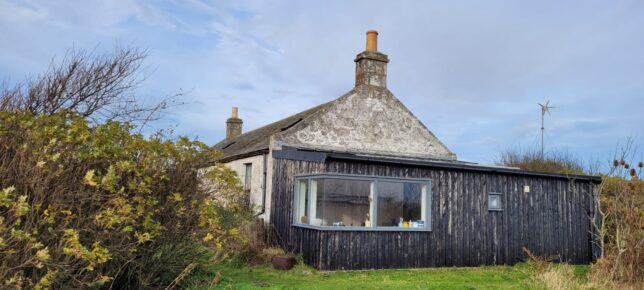
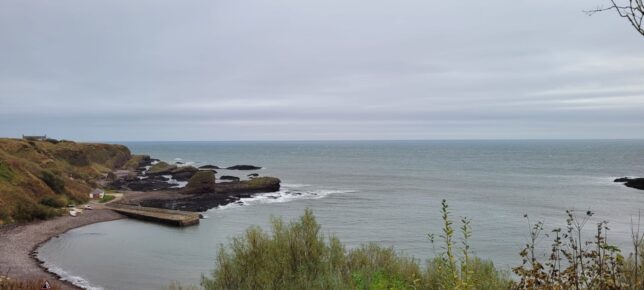
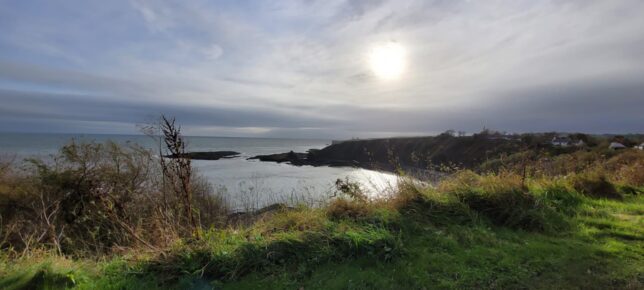
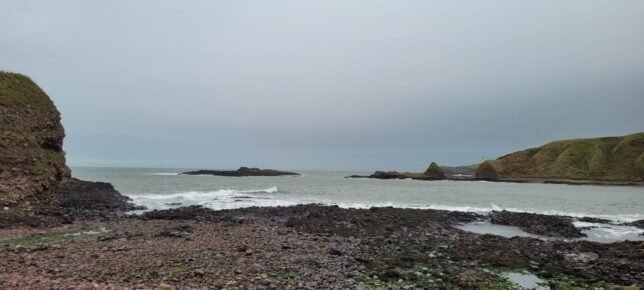
These two places that dominate her work could not appear more different at first sight – the polluted and densely populated urban Glasgow and the tiny remote Catterline with its breath taking natural beauty. However there are similarities. For example they were both inhabited by working class communities and both had an “austere nature, [be it] windswept or polluted” by industrialism. Both arguably show a “true sense of Scottishness – weathering the elements, whether natural or other.” (Source 8).
At first glance it would appear that Joan’s paintings of Catterline are quite abstract and expressionist with their sweeping brush strokes. But when you observe the coast of Catterline and compare it with her paintings you can see how her works really capture the landscape. You can match features from the landscape with features in her paintings. Her aforementioned skill at drawing meant she was able to create an accurate likeness.
Joan painted on the beach and transported her materials to and from her studio using a scooter. She utilized ropes as well as big rocks from the stone beach to weigh down her canvases and often used natural materials like grass, flower heads and seeds as a medium. She would paint outside during storms. When she was back in Glasgow she asked her neighbours in Catterline to notify her when a storm was approaching. There are photographs of Joan taken by Audrey showing her with a weighted-down easel. (Reference 11),
The painting entitled “Flowers” is believed to have been created in 1962, the year before Joan died of breast cancer. I personally feel that, although the flowers themselves are beautiful, there is a sense of entrapment and claustrophobia created by the choice of colours for the background and the darker shades coming in from the corners. Perhaps I feel this way as I know Joan was forced to paint indoors during periods of ill health, unable to capture nor feel the immense power of the natural elements that had been so central to her paintings prior to that. Despite the feeling of darkness closing in, the flowers also serve as a symbol of hope with their colourful beauty in the centre of the painting.
https://www.nationalgalleries.org/art-and-artists/92112?artists%5B3222%5D=3222&search_set_offset=2
Joan was elected a full member of the Royal Scottish Academy in 1963, an achievement she only got to enjoy for a few months before she passed away. Even today this accomplishment is a huge honour that few artists are offered and is all the more remarkable given that Joan painted during a time when society was much more male-dominated than it is nowadays.
Not only was society more patriarchal when Joan was alive but it was also more homophobic. Joan was a lesbian living in a time when many kept their sexuality hidden. Her relationship with some of her closest female friends is believed to have been romantic but this is not known for certain. (Reference 2).
What is it about Joan’s work that has endured for decades after her death? Perhaps it is the universality of her seascapes. Even without knowing Catterline, you can look at one of her paintings and be transported to the cliffs, practically able to smell the salty air and feel the wind against your face. Or perhaps it is the way her portraits of children seem to capture the subject’s cheekiness and spirit. Her paintings are full of life and almost act as time machines transporting the viewer back to a specific place and point in history.
After Joan passed away on 16th August 1963 her ashes were scattered on the beach in Catterline. Despite Joan being taken from the world far too early, her “incredible body of work has endured long beyond her lifetime and continues to inspire new generations of artists”. (Reference 2).
Here is a list of books about Joan’s life and works available in the library. Please note that these are reference books which cannot be borrowed but you can spend as much time as you like reading them in the library building:
- Joan Eardley: A Sense of Place by the Scottish National Gallery of Modern Art
- Joan Eardley by Christopher Andreae
- Joan Eardley, RSA by Cordelia Oliver
I was over the moon to get the opportunity to visit Catterline in early November 2021 and took the photos included in this post. A big thank you to my partner David for organising our trip and to Stuart who is an incredible artist we met in Catterline – he gave me lots of extra information about Joan!
References
- A link with biographic details about Joan:
https://www.nationalgalleries.org/art-and-artists/features/joan-eardley - A three part podcast about Joan’s relationship with Catterline, her personality and sexuality and the materials she used:
https://www.nationalgalleries.org/art-and-artists/features/joan-eardley-podcast - More information on Joan’s life and works:
https://www.nationalgalleries.org/art-and-artists/features/story-scottish-art-joan-eardley - A link where you can see pictures of Joan’s work:
https://www.nationalgalleries.org/search?artists%5B3222%5D=3222 - A link with more information about Catterline:
https://www.undiscoveredscotland.co.uk/catterline/catterline/index.html - Wikipedia entry about Catterline:
https://en.wikipedia.org/wiki/Catterline - An article about Joan’s work in the Guardian:
https://www.theguardian.com/artanddesign/2017/feb/10/joan-eardley-the-forgotten-artist-who-captured-scotlands-life-and-soul - A link that explores the relationship between Joan’s main subject matters – the children of Glasgow and the landscape of Catterline:
https://www.studiointernational.com/index.php/joan-eardley-a-sense-of-place-review-national-galleries-scotland - A link to an image of the pastel sketch “A Pair of Oxen”:
https://www.nationalgalleries.org/art-and-artists/2/pair-oxen - A link to an image of the painting entitled “Flowers”:
https://www.nationalgalleries.org/art-and-artists/92112?artists%5B3222%5D=3222&search_set_offset=2 - A link to a photograph of Joan painting on Catterline beach taken by her friend Audrey Walker. You can also buy it as a postcard here!
https://www.nationalgalleries.org/shop/stationery/postcards/joan-eardley-painting-sea-catterline-audrey-walker-a5-postcard - A webpage about Joan’s position with specific regard to the Royal Scottish Academy:
https://www.royalscottishacademy.org/2021/05/18/joan-eardley-rsa-at-100/ - A link with many resources about Joan as well as information about how the centenary of her birth is being celebrated:
https://joaneardley.com/ - A biography of Joan which includes a timeline:
https://joaneardley.com/biography

2 replies on “Joan Eardley (1921-1963)”
What an excellent and informative piece of work on Joan, well done to all. So interesting. Thank you Holly.
I really enjoyed reading this blog. I am a big fan of Joan Eardley. Unfortunately, I won’t be able to visit the GWL for the exhibition there as I live in Aberfeldy and don’t have a visit to Glasgow planned for the near future. I did go to the Joan Eardley exhibition at Perth Museum and Art Gallery, which I enjoyed, and also the major Exhibition at the Modern Art Gallery in Edinburgh a few years back. However, I learned a lot through your blog and appreciated your insights as well as the interesting links at the end. Good job, Holly!